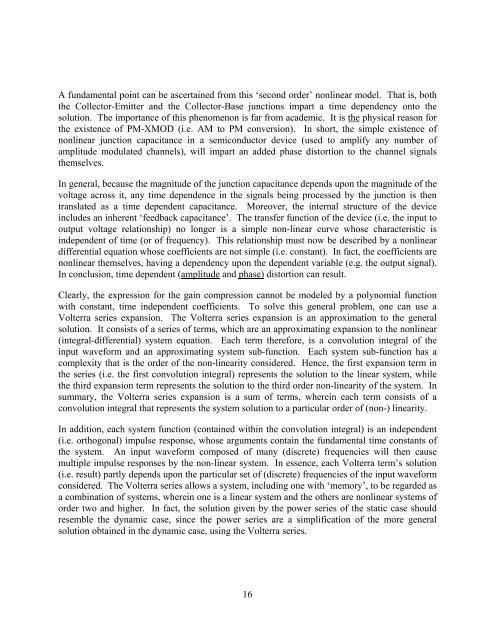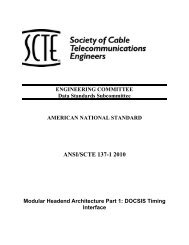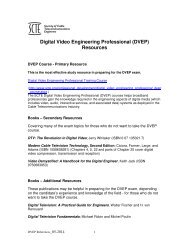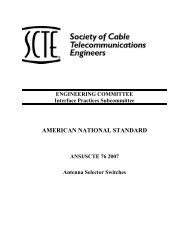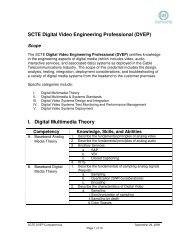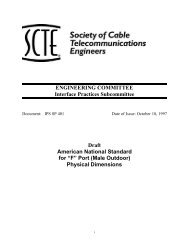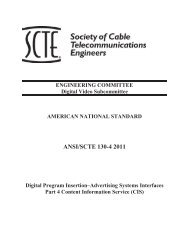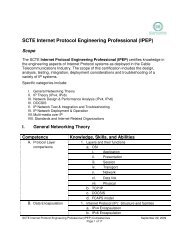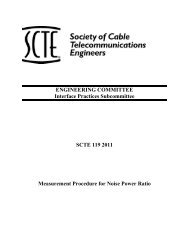SCTE IPS Template, Rev 2
SCTE IPS Template, Rev 2
SCTE IPS Template, Rev 2
- No tags were found...
You also want an ePaper? Increase the reach of your titles
YUMPU automatically turns print PDFs into web optimized ePapers that Google loves.
A fundamental point can be ascertained from this ‘second order’ nonlinear model. That is, boththe Collector-Emitter and the Collector-Base junctions impart a time dependency onto thesolution. The importance of this phenomenon is far from academic. It is the physical reason forthe existence of PM-XMOD (i.e. AM to PM conversion). In short, the simple existence ofnonlinear junction capacitance in a semiconductor device (used to amplify any number ofamplitude modulated channels), will impart an added phase distortion to the channel signalsthemselves.In general, because the magnitude of the junction capacitance depends upon the magnitude of thevoltage across it, any time dependence in the signals being processed by the junction is thentranslated as a time dependent capacitance. Moreover, the internal structure of the deviceincludes an inherent ‘feedback capacitance’. The transfer function of the device (i.e. the input tooutput voltage relationship) no longer is a simple non-linear curve whose characteristic isindependent of time (or of frequency). This relationship must now be described by a nonlineardifferential equation whose coefficients are not simple (i.e. constant). In fact, the coefficients arenonlinear themselves, having a dependency upon the dependent variable (e.g. the output signal).In conclusion, time dependent (amplitude and phase) distortion can result.Clearly, the expression for the gain compression cannot be modeled by a polynomial functionwith constant, time independent coefficients. To solve this general problem, one can use aVolterra series expansion. The Volterra series expansion is an approximation to the generalsolution. It consists of a series of terms, which are an approximating expansion to the nonlinear(integral-differential) system equation. Each term therefore, is a convolution integral of theinput waveform and an approximating system sub-function. Each system sub-function has acomplexity that is the order of the non-linearity considered. Hence, the first expansion term inthe series (i.e. the first convolution integral) represents the solution to the linear system, whilethe third expansion term represents the solution to the third order non-linearity of the system. Insummary, the Volterra series expansion is a sum of terms, wherein each term consists of aconvolution integral that represents the system solution to a particular order of (non-) linearity.In addition, each system function (contained within the convolution integral) is an independent(i.e. orthogonal) impulse response, whose arguments contain the fundamental time constants ofthe system. An input waveform composed of many (discrete) frequencies will then causemultiple impulse responses by the non-linear system. In essence, each Volterra term’s solution(i.e. result) partly depends upon the particular set of (discrete) frequencies of the input waveformconsidered. The Volterra series allows a system, including one with ‘memory’, to be regarded asa combination of systems, wherein one is a linear system and the others are nonlinear systems oforder two and higher. In fact, the solution given by the power series of the static case shouldresemble the dynamic case, since the power series are a simplification of the more generalsolution obtained in the dynamic case, using the Volterra series.16


